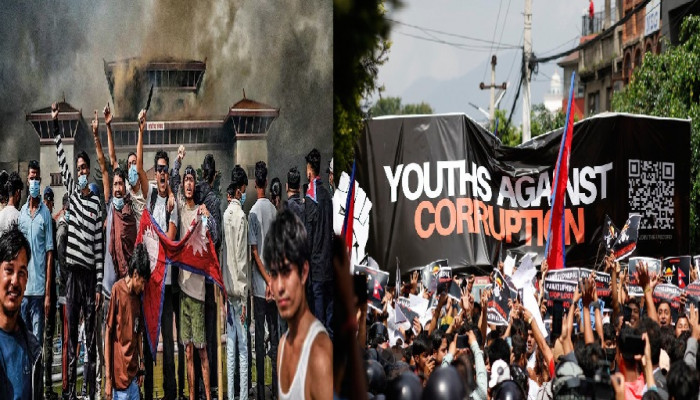Nepal’s Regime Change: Are Gen Z Youth Getting Played?
- In Military & Strategic Affairs
- 07:31 PM, Oct 03, 2025
- Khushi Mishra & Dr. A. Adityanjee
The political landscape of Nepal, long characterised by long cycles of instability and elite power struggles, recently witnessed an explosion of youth outrage that was as swift as it was consequential. In September 2025, a seemingly innocuous government ban on the social media platforms for failure to register by foreign social media behemoths became the spark that ignited the so-called "Gen Z Uprising," forcing the resignation of the then Prime Minister K P Sharma Oli and dissolving the Parliament in a matter of days. This wasn't just a street protest; it was a more widespread generational roar against endemic corruption, economic hopelessness, nepotism and the vulgar display of wealth by a geriatric political class that had monopolised power for decades and promoted and indulged their own “nepo-kids”.
This dramatic regime change, catalysed and coordinated by a digitally native generation on platforms like Discord and Instagram, presents a critical question: Did Nepal's youth merely provide the revolutionary fuel, only to have the political elites seize the steering wheel once the old guard was ousted? Are the so-called Gen Z youth, the true architects of this upheaval, now at risk of being sidelined, co-opted, or worse, played by the very system they risked their lives to dismantle?
Western media’s irrational fascination with the label Gen Z protest has been remarkable in this whole saga of the protest of the Nepalese youth movement. First, the age groups involved in this Nepalese protest movement included school children in their teens to adults in their fifties, involving almost all sections of society, including students, unemployed youth, middle-aged citizens and ordinary citizens of that country. It is highly debatable whether the American sociological classification of generational cohorts is similarly applicable to Nepal as to the US. To romanticise a specific age group also reflects the true intent of the ideological backers of this protest movement, who are using lofty notions to justify the regime change agenda.
From a definitional perspective, Generation Z, often shortened to Gen Z and informally known as the zoomers, is the demographic cohort succeeding Millennials and preceding Generation Alpha. Academics use the mid-to-late 1990s as starting birth years and the early 2010s as ending birth years, with the Generation Z loosely being defined as people born from 1997 to 2012. The protest movement in Nepal was not confined to this specific age group and involved everyone except for senior citizens in that country.
The core of the recent crisis is a fundamental generational rupture with the democratic political system established after the 2006 democracy movement and ouster of the absolute monarchy. This popular revolt led to the arrival of Western NGOs in Nepal that had their own pernicious agenda, including religious conversions of the poor masses. Nepal’s political class, with Western support, boasted of having created a constitution that was perceived as the best in South Asia. That democratic revolution promised a prosperous, inclusive, secular and accountable Nepal.
Instead, Gen Z grew up in a republic defined by gerontocracy and the 'Big Three' political parties - the Nepali Congress, UML, and the Maoists, who rotated power with an almost theatrical lack of ideological difference, their unity reserved only for self-preservation. The Nepalese political elite (including the monarchy itself, Maoists, democrats, party-less royalists, constitutional monarchists, and communists) was always adroit at finger-pointing at the Southern neighbour India for all their perceived failures to deliver reforms, development, economic success and prosperity to their own population.
The tendency was to play the China card against India by whoever was in power, while blaming India for all the ills of Nepal. Former Nepalese Prime Minister KP Sharma Oli was reflexively quick to blame India for his ouster, claiming that his statements on the Ram Temple issue were not liked by the Indian government, leading to the instigation of protestors.
The youth who led the September 2025 protests were not politically passive; they were politically disillusioned.
The Reality that Fuelled the Rage
Economic Precarity: Youth unemployment in Nepal consistently hovers over 20%, forcing hundreds of thousands to seek jobs abroad. Every day, two thousand Nepalese youth leave their motherland to seek employment abroad. Remittances account for over a quarter of Nepal's GDP, a national testament to the failure to create opportunity at home. It was sad to see 1200 Nepalese youth lose their lives while doing construction jobs in the desert heat of Doha, Qatar, for the FIFA World Cup tournament, 2022. None of the government functionaries in Nepal did anything about the loss of the lives of young Nepalese.
Elitist Corruption: A torrent of corruption scandals, involving former prime ministers and senior bureaucrats, has created a crisis of legitimacy. This was amplified by the viral #NepoKids trend, where the children of the ruling elite, whether of so-called democratic leaders or scions of the former royal family, shamelessly flaunted their wealth on social media, a stark contrast to the average Nepali citizen's income of barely $1,400 per year.
A Gerontocracy's Grip: With over 56% of the population under thirty, the average age of the political leadership stood around seventy. This geriatric leadership was woefully out of touch, viewing youth discontent as a mere annoyance rather than a seismic force.
When the government banned social media platforms for failure to register under domestic law, the youth saw it not as a regulatory move, but as a decadent regime's final, arrogant attempt to silence their criticism.
Though the ban was revoked, it did not stop the fury. The subsequent, deadly police response, in which over seventy people were killed, transformed an anti-corruption protest into a national fury against state violence, resulting in the burning of party offices, hotels, private homes, the parliament building and the administrative offices in Singha Darbar and the dramatic downfall of the Oli government.
The Infiltration of the Revolution: An Old Trick in a New Era
The question of whether Gen Z is "getting played" arises immediately in the aftermath of their victory. History contains examples of popular, organic movements co-opted by established forces. In Nepal, two key forms of potential manipulation stand out: co-option and structural hijacking.
1. Co-option: The Trojan Horse of Interim Power
The immediate outcome of the uprising was the appointment of an interim government led by Sushila Karki, a former Chief Justice renowned for her integrity. Her selection was, in part, a symbolic victory for the youth, who organised an online, citizen-driven vote for the new leader. This appears to be a triumph for digital democracy. A section of these youth leaders was pushing for Balendra Shah, 33-year-old mayor of Kathmandu and a former rapper, to be the new Prime Minister, reminding of a Ukraine-like situation where an untested comedian and actor with no political experience was pushed through elections to the office of the President, leading to disastrous results for the Ukrainian nation. Balen Shah of Madhaishi's background has been highly critical of India and supported the irredentist Greater Nepal claims. In 2023, he placed a map of Greater Nepal in his personal office, an act that caused considerable controversy in India.
However, a careful examination reveals the political class quickly sought to manage and contain the energy of the movement.
- The Infiltrated Leadership: While the protests started organically through groups like Hami Nepal and decentralised Discord channels, reports emerged that the escalation of violence, the looting and arson may have been hijacked by external forces and political party cadres. The credentials of Hami Nepal, its 36-year-old leader, Sudan Gurung and its funding from Barbara Adam Foundation and other sources itself is very suspect. Since its inception in 2015, there has been a meteoric rise in funding for Hami Nepal from questionable sources and individuals and corrupt arms dealers. This infiltration of the initial peaceful youth protest allowed established players to channel the chaos, shifting the narrative from a genuine youth movement to a security crisis, justifying their continued involvement in the "transitional" process. There were records of very precise instructions on the Discord chat platform to cause mayhem and property destruction in some of these chats.
- The Symbolic Head, the Old Body: While Sushila Karki's appointment is a fresh face, the entire apparatus of the state - the bureaucracy, security forces, and the Election Commission remains structurally intact and still loyal primarily to the major political parties that appointed their personnel. Youth achieved a leadership change, but not a systemic change.
2. Structural Hijacking: The Game of Fragmented Power
The actual danger of co-option lies in the transition to new elections, scheduled for March 2026. The humbled but not broken major parties are now positioning themselves to absorb the anti-establishment sentiment without reforming their core practices.
The system itself is the primary tool of manipulation:
- The Migration Gap: An estimated 3 million to 3.5 million Nepali citizens, mostly youth, live and work abroad. Since Nepal's electoral law offers no provision for absentee voting, this massive demographic, the most deeply disillusioned and powerful source of remittances, is silenced at the ballot box. Their voices may overturn a government via the streets, but they are excluded from formal regime change via the vote.
- The Age Barrier: Legal and political barriers, such as age restrictions for running for federal positions (often 25 years old), actively exclude the younger end of the Gen Z spectrum from holding influential office, leaving the reins of formal power with the older generations. However, this is not an uncommon issue in other democracies where there is a minimum age for running for higher offices.
The most significant risk is that the old political syndicates will skillfully use the fragmented nature of the youth movement, which is currently unified by anti-corruption rage but not by a single, cohesive political party, to reassert their dominance through coalition politics, rendering the street revolution a temporary detour rather than an actual turning point.
Future Trajectory
The long-term trajectory for Nepal hinges on the resolution of various dichotomous factors. There are multiple fault lines between monarchists versus democrats, democrats versus Maoists, Hill people versus Madhaishsis, Sinophils versus Indophils, Seculars versus proponents of Hindu Rashtra, youth versus geriatric class, #Nepokids versus common man, etc. An important question is whether the so-called Gen Z generation or the youth movement can evolve from a mere protest movement to a sustainable political force. This requires a crucial shift in strategy:
- From Discord to the Ballot: The energy of the uprising must be channelled into a political party or a unified front capable of contesting the upcoming elections. The youth must field credible, uncorrupt candidates who can translate street demands into legislative power, challenging the established parties where it hurts most- their majoritarian base.
- Bridging the Divide: The movement must address its fragmentation, moving beyond the single-issue cri de cœur of anti-corruption to develop a cohesive platform on economic policy, foreign policy, and institutional reform.
- Institutionalising Digital Power: The interim administration must be pressured to implement long-overdue electoral reforms, including granting voting rights to millions of citizens working abroad, ensuring the remittance economy is no longer disenfranchised.
- Constitutional Reforms: The new national parliament will need to tackle the issue of constitutional reforms so that corruption can be weeded out and the system develops safeguards to avoid the recurrence of similar problems in future.
Suppose the youth fail to organise and enter the formal political arena. In that case, their revolutionary zeal will be, as one commentator put it, "a beautiful moment of fury that changes the face of the government but not the soul of the state." The youth uprising was a glorious display of popular sovereignty, proving that the old guard could be toppled just like the absolute monarchy was toppled in 2006. The actual test is now whether the architects of the regime change can avoid becoming pawns in the new political game, possibly sponsored by foreign backers. The streets have spoken; the ballot box must deliver to the common man. The moment for youthful idealism is over; the time for cold, complex political strategy has begun.
Disclaimer: The opinions expressed within this article are the personal opinions of the author. MyIndMakers is not responsible for the accuracy, completeness, suitability, or validity of any information on this article. All information is provided on an as-is basis. The information, facts or opinions appearing in the article do not reflect the views of MyindMakers and it does not assume any responsibility or liability for the same.







Comments